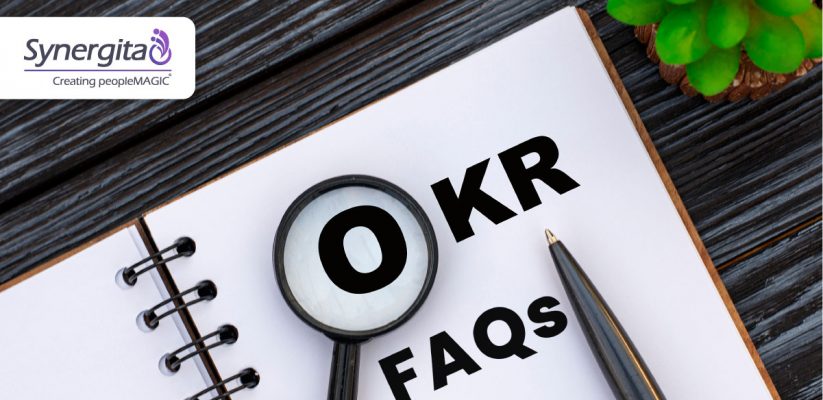OKR FAQs to Take Your Enterprise Onward
Objective and Key Results (OKRs) are gaining traction as it is used by several industry leaders. OKRs are a great way to ensure your team is on the same page and focused on the right things, but getting started with this new methodology and determining if it’s working for you can be difficult.
We’ve put together these answers to a few common questions about OKRs. The answers to frequently asked questions on OKR in this article will give you a better understanding of what they are and how they work.
OKR FAQs
What are Objectives and Key Results?
OKRs are a powerful way to set and track objectives. It involves setting specific objectives, which are then achieved with quantifiable metrics called key results.
An objective is to be achieved through a measurable and verifiable result within a certain time, for example, creating a new product or increasing sales by 10%. It should be specific, meaningful, and realistic. It should also be related to your enterprise’s mission. A key result is a step you take to achieve your objective. A key result should be actionable and quantifiable, meaning that it has clear steps to follow to achieve your overall objective.
OKRs are intended to drive innovation and growth within your enterprise as a robust methodology. They’re used by some of the world’s most successful organizations, including Google, Amazon, Facebook, LinkedIn, etc.
Why use Objective and Key Results?
Targeted objectives lead to better results than ambiguous ones. Objectives and Key Results help you focus on outcomes that matter. OKRs help employees focus on what matters, so they can be more productive and effective at work. They also allow teams to align around shared objectives and deliver better results. They help keep your team on track so they can achieve more than they could without the clear OKRs. With OKR, individuals are encouraged to set their own objectives by identifying the problems they want to solve and creating solutions for those problems. It empowers employees by allowing them to determine their career prospects rather than having those objectives dictated by a manager or executive team.
How do I set up an objective using OKRs?
First, you need to define your objective. Ask yourself what do you want to achieve? Then you can set three key results that will help you achieve that objective, such as the steps you need to take to get there? Finally, you need to define how success will be measured for each key result and how will you know when you’ve achieved it? Once all these elements are in place, it’s easy for everyone on your team to understand their role in achieving this objective.
Who uses OKRs?
Google is famous for using OKRs, but you don’t need to be a tech giant to use them. In fact, there’s no shortage of enterprises that use OKRs in some form or another, including Microsoft, LinkedIn, Facebook, and more. OKRs are great at unifying your team towards a shared objective. While that is more beneficial in larger enterprises than smaller ones, OKRs have the additional benefit of actualizing your business objectives in a quantifiable process.
How do I know if my enterprise needs OKRs?
use OKRs is to ask yourself if you want engaged employees who drive profits for your enterprise.
If the answer is yes, you probably want to start using OKRs.
OKRs are a great way for enterprises to align their employees around specific objectives that will help them increase their bottom line. With the proper understanding and training, it’s easy for anyone in your enterprise to set up an OKR and start working towards it quickly.
How often do I have to change my OKRs?
That depends on how quickly things are changing in your business. If you’re a startup or a fast-moving company, you may need to change your OKRs weekly or daily. On the other hand, if your enterprise is more stable and predictable, you might shift your OKR objective every quarter or even annually. The key here is to ensure that whatever time frame you choose allows enough time for everyone involved in setting those objectives. They can make an informed decision on the relevance of the objectives for moving forward but without too much time they lose focus.
What is OKR Software?
OKR software is a tool for establishing opportunities for self-improvement- improvement and key results. It is a straightforward, user-friendly tool with a framework for forming a unified, result-driven team in your organization. It monitors and analyses real-time progress, aligns objectives with organization objectives, and assists employees in staying focused. OKR software also generates analytical reports with accurate metrics.
What does OKR software do?
OKR software assists you in setting objectives and a strategy for achieving them. The software also tracks your progress toward those objectives and provides feedback on how to improve your performance or adjust your strategy as needed.
Why use OKR Software?
OKR software provides structure and accountability, which are both necessary for success in any endeavor. Regular updates on progress toward objectives help keep everyone focused on what needs to be done next to achieve results.
These FAQs should assist you in implementing OKR software to help you progress to the next level. OKRs can help to align organizational objectives and ensure employee accountability. They assist businesses in growing collaboratively, ensuring that individual employees become a part of the enterprise’s growth.

